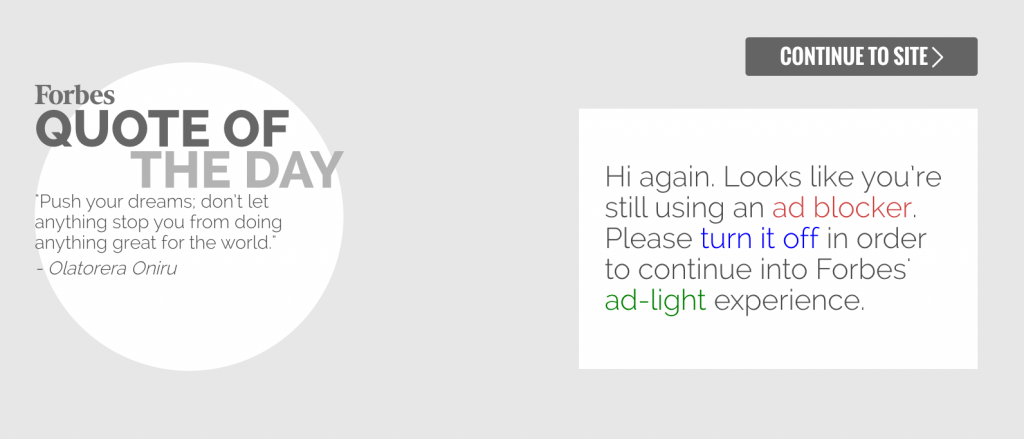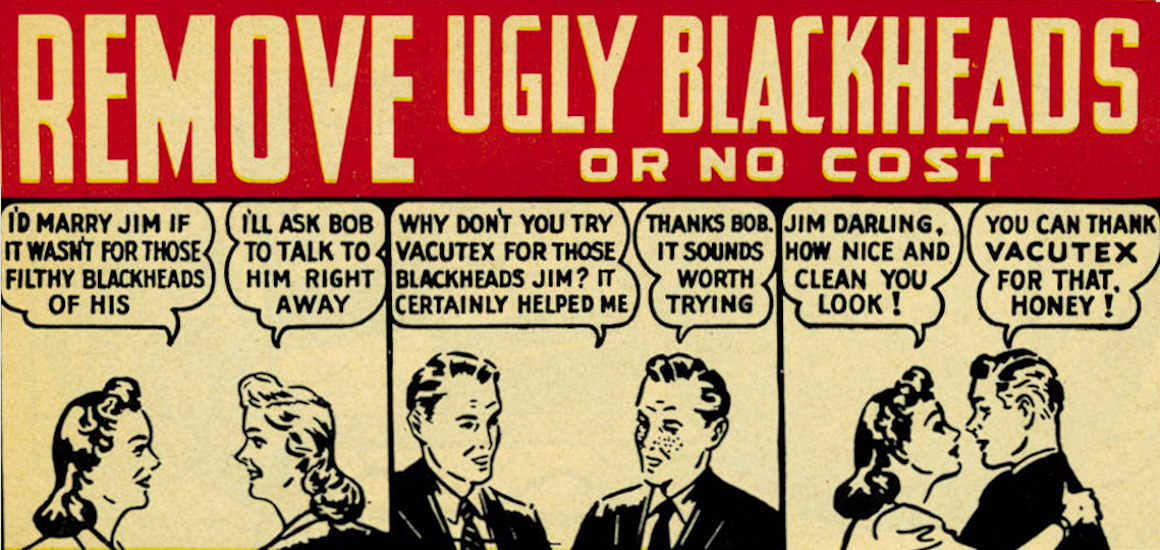Crikey, marketers and publishers can be slow on the uptake sometimes. Advertising revenue has been declining for decades, leading many to predict the long and painful death of traditional media business models. Add to this the rapid increase of ‘banner blindness‘ – as skeptical website visitors filter out display advertising by either ignoring it or using an ad blocker – and publishers have found themselves at war with their own readerships.
I began using an ad blocker a few months ago. Sure, I know many people who have used them for years, but as a marketer who also runs workshops and writes about online marketing, it made sense for me to keep an eye on what advertising was out there. Eventually, even I found the experience increasingly irritating until I simply wanted the constant interruptions and irrelevant grabs for attention out of my way.
Certainly, some websites have taken display advertising to ridiculous extremes in an effort to shore up a crumbling business model.
Anyone know what movie this is advertising? pic.twitter.com/9dWLJ9grjU
— Anna Spargo-Ryan (@annaspargoryan) March 3, 2016
Sure, not all display advertising is as unsubtle as the above, but the trend is increasingly desperate.
A bad DEAL for readers
Switching on an ad blocker for the first time in years was a surprising experience. While I had quieted many of the interruptions, I began to encounter something possibly even more annoying – publishers begging me to switch my ad blocker off. Some sites simply plead with me to add the URL to my whitelist; “Help us continue to provide you with quality content”. Others hit me with a doorway page, firmly denying me access to the content while I continue using my ad-blocker.
The Interactive Advertising Bureau (IAB) devised a handy acronym to educate publishers and advertisers on how to treat visitors with ad blockers.
D – Detect ad blocking software, in order to initiate a conversationE – Explain the value exchange that advertising enables
A – Ask for changed behavior in order to maintain an equitable exchange
L – Lift restrictions or limit access in response to consumer choice
I came across this acronym only recently, in the Ad Nauseum section of the latest issue of UK satirical magazine Private Eye where it was suitably ridiculed.
So the ad industry’s solution to the fact that everyone hates their ads online is to, er, get publishers to beg readers to put up with them. Making better, or at least less irritating ads would perhaps be just too hard.
Private Eye: issue 1414, 18 March 2016.
Exactly. The very idea pits publishers and advertisers against their own readerships. Rather than change their own behaviour, advertisers and publishers are demanding visitors change theirs instead. This is trying to solve a problem by completely ignoring the cause. Instead of tackling why customers consider the existing advertising model such a terrible experience and finding a better way, publishers are trying to make the ad-free alternative an even worse experience.
Forbes is a perfect example. Click a link to Forbes and you’re hit with a message that counts down three seconds before blocking access to the content. This replaces the previous advertisement that would inevitably force three seconds of attention from me before I could click the “Continue to Site” button.

If you are guilted enough to switch your ad blocker off, Forbes promises an ‘ad-light’ experience for 30 days. This ad-light version still has plenty of ads, but according to Digiday’s experiments, this spares the reader from only the most irritating ad formats – animated ads and autoplay video. “For instance, the top story on the site with the “ad-light experience” still serves a 730 x 90 leaderboard, three 300 x 600 pixels display ads, along with eight “from the Web” paid content placements.”
Within a few weeks, these new doorway pages and pop-up messages began to interrupt and annoy me almost as much as the advertising I was trying to avoid. Previously, I could at least choose to ignore most display advertising, but now many websites were forcing me to make extra clicks and even update my browser extension just to read a short article. When someone shares a link with me on Twitter, it shouldn’t be an epic journey for me to check it out. Sometimes, I would oblige by hitting the “one time only” setting on my ad blocker, while on other occasions the guilt-tripping interruption would irritate me enough to click the back button instead.
OK, I get that Forbes (and other publishers) need to make money to continue producing the content. Of course I get it. But maybe, just maybe, forcing readers to accept advertising they clearly don’t want isn’t the best way to build loyalty. Maybe, just maybe, bad display advertising practices are causing more damage than good.
The pickle analogy
Ever since I was a boy, I’ve always taken the pickles off burgers. Can’t stand them. Even the juicy residue is enough to put me off. So when eating at a certain burger establishment, I always take the option to customise my order. “No pickles, please”. Having worked as a burger flipper in said establishment as a teen, I know such orders are not uncommon. But “hold the pickles” orders naturally introduce inefficiencies into the kitchen that is trying to churn out a steady production line as quickly as possible – the heart of the fast food model.
Now imagine if said establishment decided to stop allowing customers to customise their orders according to personal likes and dislikes. Imagine if the paper-hatted till jockey responded to my request by pointing to a sign that said; “If you want to enjoy our exclusive special sauce, you need to accept the pickle”. If you put a pickle on my burger, I’m still not going to eat it. Plus my burger will still taste worse for the unwanted intrusion. Special sauce be blowed! I’m going for a kebab instead.
Isn’t this exactly how many publishers are currently fighting the ad blocker war? Some people don’t mind the ads, just as millions of people still inexplicably allow pickles on their burgers every day. But an increasing number of people do mind the ads. And when we find a way of customising our content snack to *ahem* “remove the pickle”, we’re told we have to eat it or don’t come back.
If that’s how publishers want to play it, fine. There is plenty of other content competing for my attention. After all, this is a readers’ market where at any time everyone has access to more content on every conceivable topic than they could ever hope to consume. So, unless your content is so earth-shatteringly exclusive and valuable that the inconvenience of missing it outweighs the irritation of advertising, then the argument to switch off my ad blocker isn’t a strong one.
And, let’s be honest, most content – particularly of the listicle, mass-produced, production line variety – currently falls well below that essential, unmissable, exclusive bar.
Wasted impressions and pity clicks
So if a publisher does convince a reader to switch off their ad blocker. Does this mean they’re any less likely to be irritated by the advertising? Does this mean they’ll give the island ads and badly-targeted campaigns any more positive attention? Will they resist switching off the autoplay video and actually watch the irrelevant and repurposed TVC? Of course not. Neilsen has proven that, even without an ad blocker, we’ve become very good at filtering out display advertising.
Over the years, I’ve occasionally visited websites that go as far as asking visitors to click at least one advert “to support our partners that helped pay for this quality content”. Aren’t “pity clicks” a teensy bit unfair on the advertisers paying for them? Surely, any advertiser wants clicks motivated by the marketing message itself, not by some misguided sense of duty or obligation to the publisher who delivers it. If clicks simply become a way for readers to support the inadequate and desperate business model of publishers, the value of those clicks becomes significantly less. And lower value clicks will eventually impact advertising rates, further cutting into advertising revenue and continuing the death spiral.
C’mon. Why can’t we come up with a better DEAL – one that readers will embrace.
D – Ditch the click bait designed purely to drive shares and impressionsE – Enhance the quality, depth and value of your content
A – Align with online behaviours and expectations for a more rewarding experience
L – Launch new revenue streams relevant to a growing audience of loyal readers
This is why content marketing – even native advertising, when it’s done well – are the best opportunity publishers and marketers have to reach the right audience with the right message in ways that don’t intrude, interrupt or irritate.
Because no one ever sold more burgers by making people eat pickles they didn’t want!
